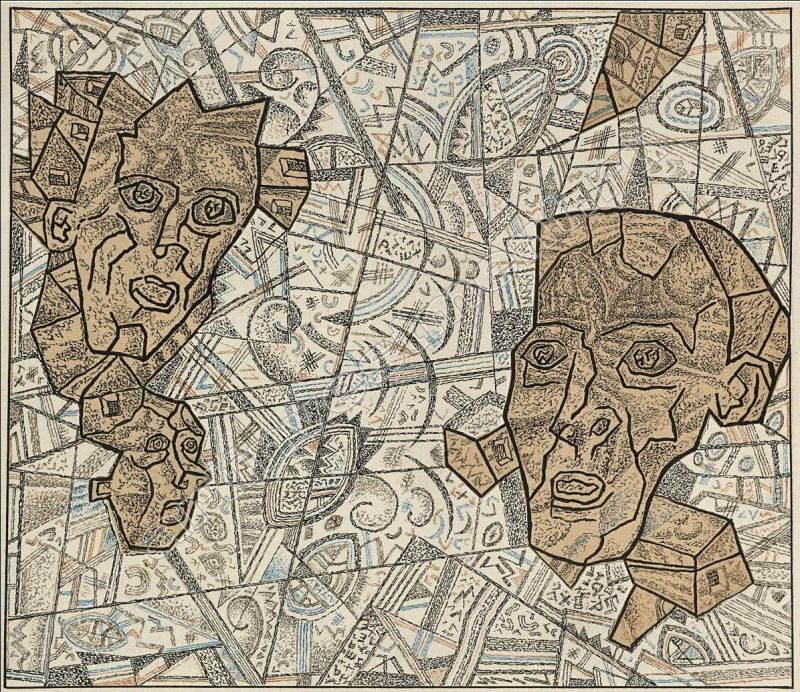Art Investment
Artist: Filonov Pavel Nikolaevich
Sales history available to subscribers
About work
CategoryMixed media
ProvenanceGalerie Gmurzynska, Cologne;Art Focus, Zurich;Acquired from the above by the present owner, 1990sEXHIBITEDDie Physiologie der Malerei; Pawel Filonow in den 1920er Jahren, GalerieGmurzynska, Cologne, 1992, no.6 p.51 (illustrated)Russisches Kunst, Art Focus, Zurich, 2003, cat. no.15, p.52 (illustrated)CATALOGUE NOTEThe present lot was most likely executed in 1922-1925 when Pavel Filonov worked extensively on paper and produced a number of compositions with heads on a dense, abstract background. Disembodied heads are one of the central themes for this intellectually driven artist. He turned to this subject as early as 1910, in Heads, the painting Filonov considered to be his first serious work. Over the following years, especially after 1918 when Filonov was actively developing his theory of Analytical Art, heads remained the only figurative element of his compositions. Emerging from the background and floating on the surface they are a striking symbol of intellectual power and the artist's presence in the painting. Their accentuated wide nostrils, peering eyes and distorted features, particularly evident in the present lot, reinforce the impression of intense mental strife.
Untitled is a vivid example of Filonov's philosophy of 'analytical painting'. Here the heads are drawn on light brown paper and glued onto a geometrical background reminiscent of the artist's abstract Formula series. The complicated, multi-faceted pattern resembles cells of a living organism that are intricately connected as if growing into each other. Every single dot here is an important and integral part of the greater picture, analysed and 'worked through' meticulously. Such attention to detail combined with a build up of artistic forms similar to those found in nature are core principles of Filonov's theory of Analytical Art that was laid out in his 1923 article, 'The Declaration of Universal Flowering'.
Working contrary to other artistic methods developed in the first part of the twentieth century, Filonov hoped to preserve his intellectual findings for posterity in a dedicated museum of Analytical Art. With this idea in mind he kept nearly all his paintings to himself, refusing commissions and sale offers. Although the project was never completed, the majority of the artist's works were given to the State Russian Museum in St. Petersburg after his death and are rarely seen on the international market.
Untitled is a vivid example of Filonov's philosophy of 'analytical painting'. Here the heads are drawn on light brown paper and glued onto a geometrical background reminiscent of the artist's abstract Formula series. The complicated, multi-faceted pattern resembles cells of a living organism that are intricately connected as if growing into each other. Every single dot here is an important and integral part of the greater picture, analysed and 'worked through' meticulously. Such attention to detail combined with a build up of artistic forms similar to those found in nature are core principles of Filonov's theory of Analytical Art that was laid out in his 1923 article, 'The Declaration of Universal Flowering'.
Working contrary to other artistic methods developed in the first part of the twentieth century, Filonov hoped to preserve his intellectual findings for posterity in a dedicated museum of Analytical Art. With this idea in mind he kept nearly all his paintings to himself, refusing commissions and sale offers. Although the project was never completed, the majority of the artist's works were given to the State Russian Museum in St. Petersburg after his death and are rarely seen on the international market.
Size, cm*20,5×18
Risk indicator
Attention! All materials of the site and database of auction results ARTinvestment.RU, including illustrated reference information about the works sold at auctions, are intended for use exclusively for informational, scientific, educational and cultural purposes in accordance with Art. 1274 of the Civil Code. Use for commercial purposes or in violation of the rules established by the Civil Code of the Russian Federation is not allowed. ARTinvestment.RU is not responsible for the content of materials submitted by third parties. In case of violation of the rights of third parties, the site administration reserves the right to remove them from the site and from the database on the basis of an application from an authorized body.

